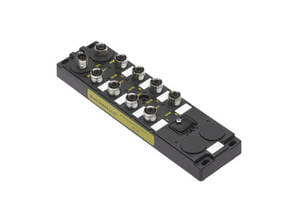Industrial-grade Ethernet Switches are designed to provide reliable connectivity in harsh environments with extreme temperatures, moisture, and vibration.
Plants are replacing proprietary protocols with integrated communication protocols using Transmission Control Protocol/Internet Protocol (TCP/IP) and Ethernet network structures to link plant floor productivity to business intelligence. Device-level networks utilize controllers to communicate machine-to-machine using popular open and proprietary protocols.
Implementing Ethernet as a link-layer protocol to legacy applications can future-proof the network and boost ROI by improving uptime and optimizing workflow and production. High-density Ethernet/IP is compatible with most versatile fieldbus automation technologies. Ethernet/IP provides the scalability needed to economically integrate the plant floor with offices enterprise-wide—and beyond for secure remote access.
A networked Ethernet/IP architecture deploying industrial-grade components can enable total integrated connectivity with sophisticated control automation at the machine level, while mining multiple data streams from the plant floor to inform enterprise-wide business strategies. Able to meet data traffic demands, without sacrificing reliability and security, Ethernet/IP has become a gold standard in commercial industrial environments. Facilitating rapid, accurate dataflow, Ethernet/IP provides shared communication on a single local area network, with access to the Internet, and the ability to integrate plant machinery and process data via Ethernet or other compatible protocols.
The physical infrastructure of a networked plant floor is substantially different from office environments. Building an enterprise-wide network requires integration of cabling, connectivity, controllers, switches and other components, and software interfaces for data transmission and mining. Plant level connections frequently span longer distances, necessitating more stringent, higher speed real-time data transmission rates. Ethernet/IP excels in the need for speed and longer runs without performance degradation.
Rapid technology enhancements have made Ethernet the mainstream enterprise-wide communication technology. Every technology offers strengths and weaknesses. Enterprise-wide integration offers business intelligence, including real-time dashboards and data snapshots for production planning, while providing advanced diagnostics and tools for quality control.
Ethernet/IP indeed delivers on the promise of near real-time machine-to-machine and machine-to-enterprise communication. The downside is commensurately higher bandwidth resource demands. Ethernet has the power and potential for creating vast raw data requiring filtering controls, segmentation, and analyses, in addition to efficient management to meet storage, redundancy, and security needs.
Ethernet/IP requires strategic planning to ensure current and future data management requirements can be met with minimal integration cost and effort as a company’s network expands. Leading machine manufacturers provide nonproprietary, cost-effective Ethernet I/O plant controls and equipment, which makes for greater interoperability. Close evaluation of plant floor equipment, PLCs and other controllers, as well as protocol implementation and software, are essential to a smooth network transition.
The benefits of an enterprise-wide convergence vary depending on company goals—and network configuration. Leveraging the full value of Ethernet/IP requires the right components, including rugged industrial Ethernet switches, IO blocks, twisted pair or fiber optic cable components. Unlike networks in environmentally controlled finished office spaces, industrial-grade components are designed for harsh environments with extreme temperatures, moisture, and vibration.
Improved reliability and longer service life offset the higher initial cost of industrial-grade components. Industrial-grade RJ-45 connectors or newer M12 circular connectors are commonly found in lengthy Ethernet/IP, ProfiNet and EtherCat network runs in plants. Particularly well suited for remote locales and spanning distances, wireless Ethernet has gained traction in some process industries. Pricier industrial-grade fiber optical cable provides high speed, bandwidth, and noise protection over longer distances than traditional copper cable.
Right time for enterprise-wide Ethernet
Some manufacturers and processors are taking an overly cautious approach to enterprise-wide network convergence. Many have used the same machine-level or network architecture for decades and hesitate to upgrade, even to a better solution, until outdated equipment breaks down. But the need to employ more advanced plant floor networking technologies is becoming clear as manufacturers look to increase operational efficiencies and bottom line profits.
As evidenced by the steady proliferation of automation and machine control over industrial networks, the right technologies—at the right time—can provide significant competitive advantages to process and manufacturing industries. Large manufacturers and process control operations are trending toward operating on enterprise-wide Ethernet platforms. A well-designed infrastructure mitigates network security risks, while providing transparency to assess what’s happening on the plant floor.
Plant equipment performance and production metrics are widely recognized as important strategic business tools to help reduce expenses and optimize uptime. Ethernet/IP and industrial-grade connectivity is at the right stage in evolution to deliver proven reliability and accessibility at an attractive price point. At the plant level, Ethernet/IP delivers improved:
- Equipment performance
- Workflow speed
- Energy efficiency
- Quality control
- Data transmission speeds over legacy platforms
- Flexibility to add remove network nodes
Advanced Ethernet/IP technologies can link machine processes, control systems, and plant-level information to the enterprise with unparalleled scalability, functionality, and options. The right architecture can incorporate wired and wireless connectivity to provide enterprise-wide access for improved business intelligence, closer monitoring and control over production, resource management, and streamlined operations.



